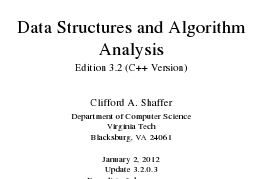 Free download Data Structure and Algorithms Analysis Edition 3.2 (C++ Version) in PDF written by Clifford A. Shaffer (Department of Computer Science Virginia Tech Blacksburg) and published by Dover Publications.
Free download Data Structure and Algorithms Analysis Edition 3.2 (C++ Version) in PDF written by Clifford A. Shaffer (Department of Computer Science Virginia Tech Blacksburg) and published by Dover Publications.
According to the Author, “We study data structures so that we can learn to write more efficient programs. But why must programs be efficient when new computers are faster every year? The reason is that our ambitions grow with our capabilities. Instead of rendering efficiency needs obsolete, the modern revolution in computing power and storage capability merely raises the efficiency stakes as we attempt more complex tasks.
The quest for program efficiency need not and should not conflict with sound design and clear coding. Creating efficient programs has little to do with“programming tricks” but rather is based on good organization of information and good algorithms. A programmer who has not mastered the basic principles of clear design is not likely to write efficient programs. Conversely, concerns related to development costs and maintain ability should not be used as an excuse to justify inefficient performance. Generality in design can and should be achieved without sacrificing performance, but this can only be done if the designer understand show to measure performance and does so as an integral part of the design and implementation process. Most computer science curricula recognize that good programming skills begin with a strong emphasis on fundamental software engineering principles. Then, once a programmer has learned the principles of clear program design and implementation, the next step is to study the effects of data organization and algorithms on program efficiency.
This book describes many techniques for representing data. These techniques are presented within the context of the following principles:
- Each data structure and each algorithm has costs and benefits. Practitioners need a thorough understanding of how to assess costs and benefits to be able to adapt to new design challenges. This requires an understanding of the principles of algorithm analysis, and also an appreciation for the significant effects of the physical medium employed (e.g., data stored on disk versus main memory).
- Related to costs and benefits is the notion of trade offs. For example,it is quite common to reduce time requirements at the expense of an increase in space requirements,or vice versa. Programmers face trade off issues regularly in all phases of software design and implementation, so the concept must become deeply ingrained.
- Programmers should know enough about common practice to avoid reinventing the wheel. Thus, programmers need to learn the commonly used data structures,their related algorithms,and the most frequently encountered design patterns found in programming.
- Data structures follow needs. Programmers must learn to assess application needs first, then find a data structure with matching capabilities.
Table of Contents
- Data Structures and Algorithms
- Mathematical Preliminaries
- Algorithm Analysis
- Lists, Stacks and Queues
- Binary Trees
- Non-Binary Trees
- Internal Sorting
- File Processing and External Sorting
- Searching
- Indexing
- Graphs
- Lists and Arrays Revisited
- Advanced Tree Structures
- Analysis Techniques
- Lower Bounds
- Patterns and Algorithms
- Limits to Computation
- Appendixes
Free download Data Structure and Algorithms Analysis Edition 3.2 (C++ Version) in PDF written by Clifford A. Shaffer from following download links.
File Size: 2.5 MB Pages: 613 Please Read Disclaimer
Don’t forget to drop a comment below after downloading this book.
Note: If download links are not working, kindly drop a comment below, so we’ll update the download link for you
Happy downloading!
Also Available: Introduction to Algorithms Third Edition in PDF